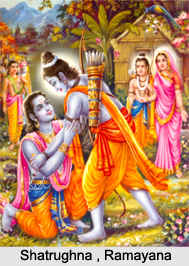 In the epic Ramayana, Satrughna was Rama`s half brother and Lakshman`s twin brother. He was son of Dasaratha, the king of Ayodhya and Sumitra. Satrughna was married to Sita`s sister Shrutakirthi. Satrughna literally means one who conquers his `Shatru` or enemies.
In the epic Ramayana, Satrughna was Rama`s half brother and Lakshman`s twin brother. He was son of Dasaratha, the king of Ayodhya and Sumitra. Satrughna was married to Sita`s sister Shrutakirthi. Satrughna literally means one who conquers his `Shatru` or enemies.
Like Lakshman, Satrughna was also easily perturbed. When Rama had to go to exile due to conspiracy of Kaikeyi and Manthara, satrughna`s anger fall upon old maid Manthara. He caught hold of her hair and pulled her to Bharatha. Satrughna even prepared to kill Manthara but Bharatha prevented him by saying Rama would not going to accept this.
When Rama became the king of Ayodhya and Bharatha was the prince, all people were happy under his rule. But suddenly Lavanasura, the son of Ravana,who was still alive became very powerful by acquiring the deadly weapon Trishula from lord Shiva and started giving a lot of trouble to the Rishis (sages) and other good people.
The Rishis could no longer bear the barbarities and prayed to King Rama to protect them by killing the demon. Rama put the responsibility of killing Lavanasura on Satrughna, who willingly accepted to go there and kill the terrible demon. Satrughna was a strong person and he had many good qualities including devotion and faith for Shri Rama.When Rama appointed Satrughna with the task of killing the demon, Satrughna touched Rama`s feet and asked Rama to put his grace on him so that he could destroy the enemy. Rama knew that Satrughna was a powerful person. So he smilingly blessed Satrughna and explained him the secrets of the weapon Trishula.
Rama told Satrughna that the Trishul was kept in the house of Lavanasura. The Rakshasa was away from his home every morning to gather his food, which primarily consisted of meat. Rama ordered that the Lavanasura should be killed before he returns home and takes his meal. Satrughna listened carefully Rama`s instruction and started, after taking his blessings. At night, satrughna rested in Valmiki`s ashram, where Sita had just given birth to Lava and Kusha.
Satrughna met Sita Devi and her twin sons. But he decided to suppress the news from Rama as he felt it would be not proper to meet Sita. As soon as Satrughna left the Ashram, he visualized Sita and Rama in his own mind and went to face Lavanasura, the frightful demon.Satrughna fought with Lavanasura and killed him. After this, Satrughna returned to Rama, touched his feet and prayed to spend the rest of his life in the feet of Rama. But Rama did not agree. He ordered Satrughna to be the king of the area where Lavanasura ruled earlier.
Satrughna obeyed Rama`s instruction and ruled the area for twelve years. He gave immense satisfaction to his subjects and protected the Sages as he ruled in an expert manner. After twelve years Satrughna could bear no more the separation from Rama and decided to return to Ayodhya. On his way back, Satrughna again spent the night in Valmiki`s ashrama. That time the two boys Lava and Kush were twelve years old and they sang beautifully the songs of Ramayana before Satrughna. Satrughna lost himself in joy and ecstasy. But he behaved in such a manner that they could not think that he was connected with them. Finally Satrughna returned to Ayodhya.
After returning to Ayodhya Satrughna described Rama his wonderful experience in Valmiki`s Ashrama. Rama being an incarnation of Vishnu, knew everything from before. But still he enjoyed the narration of Satrughna. Rama instructed Satrughna not to speak about his experience in Ayodhya at that moment.
Later, when Rama performed the Aswamedh Yajna (the horse sacrifice), Satrughna was the leader of the army following the horse.












